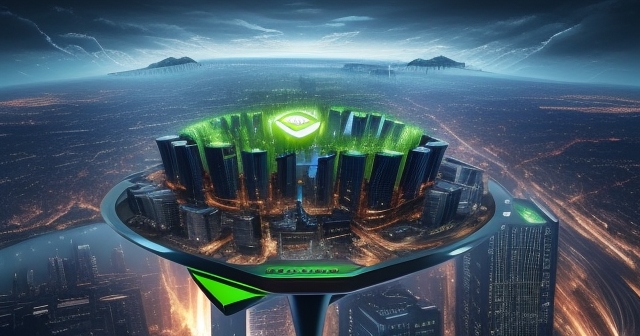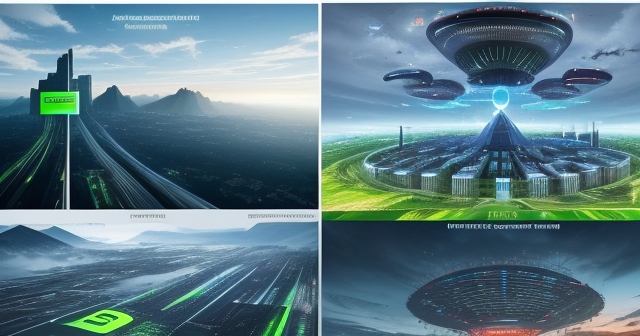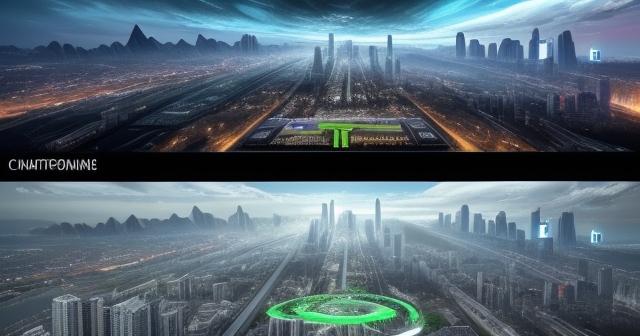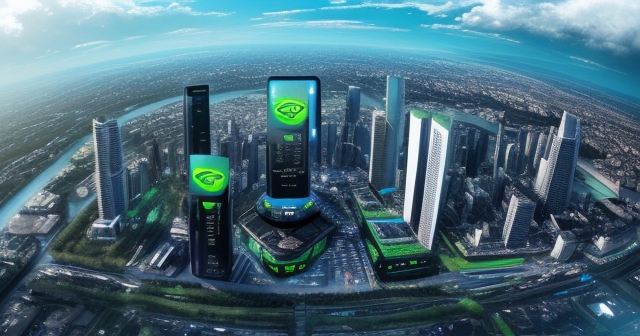Navigating the AI Epoch: Unpacking the Intertwined Fates of Nvidia and Alphabet
The landscape of modern technology is undergoing a seismic shift, driven primarily by the relentless march of Artificial Intelligence. At the heart of this revolution lie companies like Alphabet (the parent company of Google) and Nvidia, whose destinies are becoming increasingly intertwined. While market narratives often focus on stock price fluctuations or competitive skirmishes, a deeper look reveals a symbiotic relationship fueled by massive infrastructure demands and strategic collaborations. Let’s delve into the intricate dynamics binding these tech titans, particularly as illuminated by key events unfolding around February, offering valuable insights for both novice and experienced traders navigating this complex terrain.

**Key aspects of the AI landscape transformation:**
- The development of advanced AI technologies is reshaping various industries.
- Collaboration between tech giants ensures cutting-edge innovations.
- Investment in infrastructure is crucial for sustaining growth in AI applications.
Alphabet’s Strategic Blueprint: Capex Signals Trump Short-Term Misses
Around February 6, 2025, the financial world turned its attention to Alphabet’s Q4 FY2024 earnings report. On the surface, some analysts noted slight misses in revenue growth, particularly within the crucial Google Cloud segment, compared to elevated expectations. However, for those seeking signals of underlying strength and future direction, the true story lay buried in the capital expenditure (Capex) forecast. Alphabet projected a significantly higher Capex for Q1 2025, alongside robust plans for the entirety of FY 2025. This isn’t merely spending; it’s a strategic declaration of intent. It indicates that despite any short-term revenue variations, Alphabet is committing vast resources to building the foundational infrastructure necessary for future growth, particularly in AI.
Think of this like a rapidly expanding city needing more roads, power grids, and buildings. Alphabet’s cloud and AI services are the rapidly expanding city, and their Capex is the investment in essential infrastructure. When a company forecasts dramatically increased spending in this area, it tells us something critical about their expectations for demand. They wouldn’t invest billions unless they saw a clear and urgent need to expand capacity. This need stems directly from the surging demand for cloud computing and, more specifically, for the computationally intensive power required to train and run AI models – the very engines driving modern innovation.
For traders, understanding the nuance here is key. A headline reporting a “revenue miss” might trigger a negative knee-jerk reaction. But digging into the details – specifically the Capex – provides a much more optimistic long-term signal. High Capex in this context isn’t wasteful spending; it’s proactive investment in the future of AI, directly addressing a supply-demand imbalance that benefits key infrastructure providers.

**Summary of Alphabet’s strategic blueprint:**
| Aspect | Details |
|---|---|
| Quarterly Report | Missed expectations in revenue growth. |
| Capex Forecast | Significantly increased for FY 2025. |
| Market Signal | Indicates strong long-term demand expectations. |
The Infrastructure Imperative: Fueling the AI Engine Room
Why is Alphabet projecting such massive capital expenditures? The core reason, as executives like CEO Sundar Pichai have articulated, is a “tight supply demand situation” for cloud capacity, especially for high-performance computing resources essential for AI. Imagine everyone suddenly needing supercomputers, and there aren’t enough to go around. That’s the scenario playing out in the enterprise world as companies scramble to adopt AI.
Building this infrastructure requires significant investment in physical assets: new data centers, more servers, advanced networking equipment to connect everything at lightning speed, and specialized hardware like GPUs. This isn’t cheap, but it’s non-negotiable if Alphabet wants to capture the burgeoning demand for AI-powered services on Google Cloud. They are essentially saying, “The line for our AI capacity is long, and we need to build significantly more capacity just to keep up with current and projected demand.”
Consider this investment a direct pipeline to the companies that provide these critical components. Just as a construction boom benefits companies selling steel, cement, and building equipment, the AI infrastructure boom benefits companies selling the specialized hardware required. And when it comes to the most powerful processors needed for complex AI workloads, one company stands out as the dominant supplier.

**Key infrastructure investment highlights:**
| Investment Area | Importance |
|---|---|
| Data Centers | Essential for cloud services expansion. |
| Advanced Networking | Critical for high-speed connections. |
| Specialized Hardware | Need for high performance in AI workloads. |
Understanding this link between a cloud provider’s Capex and a hardware provider’s revenue is a fundamental concept for anyone analyzing tech stocks in the AI era. It shows you where the actual money is flowing and why demand forecasts from major players like Alphabet are critical indicators for companies further up the supply chain.
Alphabet’s Strategic Reliance on Nvidia: A Partnership Forged in Demand
Even as Alphabet develops its own sophisticated AI chips, known as TPUs (Tensor Processing Units), the sheer scale of the AI infrastructure buildout necessitates a continued and robust relationship with the market leader in high-end AI GPUs: Nvidia. Alphabet’s executives have been transparent about this. Sundar Pichai, for instance, highlighted their “strong relationship with Nvidia,” indicating that the demand for capacity is so immense that they require both internal solutions and external, best-in-class hardware.
Think of it like a master chef needing a variety of specialized tools. While they might forge some knives themselves (TPUs), they still need to buy the most advanced blenders or ovens from other top manufacturers (Nvidia GPUs) to run a high-capacity kitchen effectively. Google Cloud offers customers access to both Google’s TPUs and Nvidia’s GPUs, giving users flexibility depending on their specific AI tasks. However, the scale of the demand for general-purpose, high-performance AI processing means that Nvidia’s GPUs remain a critical component of Google Cloud’s expansion strategy.
This isn’t just a customer-supplier relationship; it’s a deep technical and strategic partnership. Google engineers work closely with Nvidia to optimize AI models, including Google’s own groundbreaking Gemma and Gemini models, to run efficiently on Nvidia’s hardware platforms. This co-optimization ensures that Google Cloud can offer peak performance to its customers using Nvidia GPUs, further solidifying the dependency and mutual benefit.

**Highlights of Alphabet and Nvidia’s partnership:**
| Partnership Focus | Description |
|---|---|
| Optimized AI Models | Joint effort to enhance performance on Nvidia hardware. |
| Dual Solutions | Offering both TPUs and GPUs for customer flexibility. |
| Demand Forecast | Predictable performance needs with growing AI market. |
For traders, recognizing this strong, stated partnership is vital. It counters any simplistic narrative that Google’s internal TPU development will immediately eliminate their need for Nvidia. The reality is far more complex: the AI market is growing so rapidly that both internal and external high-performance hardware are needed in massive quantities. This strong relationship provides a degree of predictability for Nvidia’s demand from a major hyperscaler like Alphabet.
Navigating Competitive Currents: DeepSeek, TPUs, and Market Noise
The AI landscape is not without its competitive pressures, and the market often reacts to potential threats. Around February, discussions sometimes included the emergence of powerful new AI models from companies like China’s DeepSeek AI, leading to speculation about whether such developments might reduce the demand for high-end GPUs. However, Alphabet’s leadership offered a counter-perspective. Sundar Pichai downplayed the immediate threat posed by DeepSeek to Google’s leading AI models and, crucially, to the overall demand for processing capacity.
Consider this a bit like the early days of the internet. Many companies launched websites, but the fundamental need for servers and data centers to host those websites only grew, regardless of which specific websites became popular. Similarly, even if new, highly efficient AI models emerge, the sheer proliferation of AI applications across industries and the increasing complexity of tasks they perform continue to drive demand for the underlying computational power.
Furthermore, while Google’s TPUs are highly efficient for certain types of AI workloads, particularly large-scale training, Nvidia’s GPUs excel in versatility and are often favored for a wide range of tasks, including the rapidly growing area of AI inference (using trained models to make predictions or decisions). The market for AI chips is diversifying, with specialized hardware like TPUs gaining traction, but the overall demand pie is expanding so rapidly that it supports growth for multiple types of processors.

**Insights on competitive currents in AI:**
| Observation | Implication |
|---|---|
| Emergence of DeepSeek AI | Speculation on reduced GPU demand. |
| Industry Growth | Continuous need for computational power. |
| Diversity of AI Chips | Multiple processor growth opportunities. |
Interestingly, reports in February 2025 also highlighted a joint investment by both Alphabet and Nvidia in the AI startup Safe Superintelligence (SSI), founded by former OpenAI chief scientist Ilya Sutskever. While SSI reportedly favors Google’s TPUs for much of its R&D, the fact that *both* Alphabet and Nvidia are investing in this cutting-edge venture underscores their shared strategic interest in the future of AI, regardless of specific hardware preferences for initial research. It’s a signal that the biggest players are collaborating on the future, even as they compete on current hardware offerings. For traders, discerning between genuine competitive threats and market noise based on specific product announcements or rumors is crucial. Listen to the commentary from company leaders on the overall market demand and their strategic investments.
A Partnership Beyond Chips: Innovation and Joint Ventures
The relationship between Alphabet and Nvidia extends far beyond the simple transaction of buying and selling chips. It’s a deep strategic alliance that spans multiple domains and technological frontiers. Events like Nvidia’s GTC conference often serve as a platform to showcase these collaborations, illustrating how the companies are jointly pushing the boundaries of what AI can do.
Think of a research university collaborating with a technology company. The university provides the groundbreaking theoretical work, and the company provides the advanced tools and platforms to turn those theories into practical applications. In this analogy, Google DeepMind provides cutting-edge AI research and models, and Nvidia provides the powerful computing platforms necessary to bring those models to life at scale.
Their collaboration includes:
-
Cloud Infrastructure Adoption: Google Cloud is an early adopter of Nvidia’s latest and most powerful AI chips, such as the GB200 Grace Blackwell Superchip and the Blackwell Ultra, demonstrating their commitment to offering customers access to the bleeding edge of AI hardware.
-
Model Optimization: Google and Nvidia work closely to optimize Google’s AI models, including Gemma and Gemini, to run efficiently and performantly on Nvidia’s platforms within Google Cloud’s Vertex AI platform.
-
Robotics: Alphabet’s robotics arm, Intrinsic, is collaborating with Nvidia, leveraging Nvidia’s Isaac Manipulator platform and Omniverse simulation technology to accelerate the development of intelligent robotic systems.
-
Drug Discovery: Google’s Isomorphic Labs, focused on using AI for drug discovery, utilizes Google Cloud, which relies heavily on Nvidia GPUs, for its intensive computational needs.
-
Energy Grids: Alphabet (via X, formerly Google[X]) and Nvidia are exploring how AI and simulation platforms like Nvidia’s Omniverse can be used to optimize complex systems such as electric grids, potentially leading to more efficient and reliable energy distribution.
-
Digital Watermarking: Google DeepMind’s SynthID, a technology for watermarking AI-generated images, had Nvidia as an early external partner, showcasing collaboration on important societal aspects of AI.
These examples paint a picture of a partnership that is deeply embedded in research, development, and the practical application of AI across diverse fields. It signifies that Alphabet sees Nvidia not just as a supplier, but as a crucial partner in innovation, further solidifying the long-term strategic importance of their relationship.
Market Valuation and February’s Symbolic Milestone
Market valuations are often a reflection of current sentiment and future expectations, and February 2024 provided a symbolic moment in the AI surge. Around February 14, 2024, Nvidia’s market capitalization surpassed that of Alphabet, briefly positioning it as the third most valuable U.S. company. This event wasn’t just a number; it was a powerful symbol of how rapidly investor optimism surrounding AI and Nvidia’s dominant position in the chip market had grown.
This surge in valuation was fueled by Nvidia’s incredible growth trajectory, driven directly by the AI infrastructure buildout at companies like Alphabet, Microsoft, Amazon, and Meta. Analysts frequently raised price targets, and forecasts for future earnings soared. However, as we moved into early 2025, market sentiment saw shifts. Concerns about the sustainability of the growth rate or high valuation multiples sometimes led to periods of stock price consolidation or dips, as Nvidia’s stock, like others, experienced volatility (e.g., a dip around 20% year-to-date as of an article referencing the February 2025 context).
Understanding market valuation requires looking beyond the headline price. Metrics like the forward Price-to-Earnings (P/E) ratio, which compares a company’s stock price to its expected future earnings, provide a snapshot of how expensive the market believes the stock is relative to its anticipated profitability. When Nvidia’s forward P/E is discussed, say around 24.6x as referenced in early 2025 contexts, analysts debate whether this multiple adequately captures the potential for continued exponential growth driven by the insatiable demand for AI processing power, particularly from hyperscalers like Alphabet making multi-year Capex commitments.

**Market valuation insights for traders:**
| Metric | Understanding |
|---|---|
| Market Capitalization | Reflects investor sentiment and growth expectations. |
| Forward P/E Ratio | Indicates valuation relative to future earnings. |
| Growth Trajectory | Critical for assessing sustainability of stock prices. |
The February 2024 milestone served as a peak of AI fervor, while subsequent market adjustments in early 2025 highlighted the natural volatility and differing interpretations of future growth potential. For traders, these moments offer learning opportunities: understanding the drivers behind valuation spikes and dips, and assessing whether current market prices reflect the underlying fundamental demand and strategic partnerships discussed earlier.
Decoding the AI Buildout: Training, Inference, and the Future Landscape
To truly grasp the demand driving the need for processors like Nvidia’s GPUs and Google’s TPUs, we need to understand the two main phases of AI workloads: training and inference. Training involves feeding vast amounts of data to an AI model to teach it to recognize patterns, make decisions, or generate content. This phase is incredibly computationally intensive and requires massive clusters of powerful processors working in parallel.
Inference, on the other hand, is when the trained model is actually used to perform a task – answering a question, generating text, recognizing an image, or making a prediction. While historically training drove much of the hardware demand, the market is now seeing a significant shift towards inference workloads. As AI models become more sophisticated and are deployed across countless applications – from search results and personalized recommendations to autonomous systems and medical diagnostics – the demand for processing power to run these models in real-time is exploding.
Consider the scale: Every time you interact with an AI-powered feature online, that’s an inference task being performed. The sheer volume of these interactions globally is staggering and growing exponentially. While inference can sometimes be less computationally demanding per task than training, the cumulative volume creates immense demand for hardware. This shift towards inference is particularly supportive of continued demand for versatile processors like Nvidia’s GPUs, which are well-suited for running a wide variety of trained models efficiently at scale.

**Future landscape insights based on AI workloads:**
| Workload Type | Demand Implication |
|---|---|
| Training | High demand for powerful clusters. |
| Inference | Growing need for scalable processing power. |
Forecasts from industry leaders like Jensen Huang suggest that global data center spending could reach $1 trillion by 2030, largely driven by the buildout of AI infrastructure. This kind of projection, if accurate, implies a sustained period of high demand for the components that make up these data centers – servers, networking, and crucially, the specialized AI processors. Understanding this distinction between training and inference, and the scale of future spending projections, helps frame the long-term demand picture for companies like Nvidia and the cloud providers like Alphabet who are building this infrastructure.
What This Means for You: Identifying Signals in the Tech Symphony
For you, as an investor or trader, understanding the dynamic between companies like Alphabet and Nvidia provides valuable insights into the broader technology market and the driving forces behind key stock movements. It’s about learning to listen to the fundamental signals amidst the market noise.
When you see a company like Alphabet committing billions to capital expenditures, interpret that not just as a cost, but as a powerful vote of confidence in the future demand for the services that spending enables. Recognize that such large-scale infrastructure buildouts have ripple effects, creating demand for suppliers further up the chain. Analyze earnings calls not just for revenue and profit numbers, but for commentary on supply-demand dynamics, capacity constraints, and strategic partnerships.
Understanding the competitive landscape isn’t just about identifying threats; it’s about recognizing the scale of the opportunity. The fact that multiple players are investing heavily in developing AI chips and models underscores the vastness of the market potential. Even with competition, the rising tide of AI demand is currently lifting many boats, particularly those providing foundational infrastructure.
Your ability to connect these dots – linking Alphabet’s Capex to Nvidia’s demand, understanding the strategic depth of their partnership, and evaluating market sentiment against the backdrop of fundamental buildout requirements – is what allows you to make more informed decisions. The events around February involving these companies serve as a microcosm of the larger trends shaping the technology sector and provide a case study in how to analyze the interplay between financial reports, strategic moves, and market reactions in the AI era.
Looking Ahead: Continued Growth and Evolving Dynamics
As we look beyond the specific events of February, the narrative remains clear: the demand for AI infrastructure is immense and continues to be the primary growth engine for companies like Alphabet and Nvidia. Alphabet’s aggressive capital expenditure plans signal a multi-year commitment to expanding its cloud and AI capacity, a commitment that directly translates into sustained demand for Nvidia’s high-performance processors.
While competitive dynamics will continue to evolve, with Google’s TPUs and chips from other players like Amazon vying for market share, the sheer scale of the AI buildout suggests that demand for both specialized and general-purpose high-end AI hardware will remain robust. The deep strategic partnership between Alphabet and Nvidia, extending across multiple areas of innovation, further solidifies the foundation of this relationship, suggesting long-term collaboration beyond simple transactions.
Market valuations will inevitably fluctuate, reflecting shifting sentiment and near-term performance. However, for those with a longer-term perspective, the underlying fundamental demand signals from major players like Alphabet, combined with the scale of the AI opportunity, paint a picture of continued growth potential for both companies.
Navigating this epoch requires a blend of understanding market mechanics and the fundamental drivers of technological change. By carefully analyzing financial reports, strategic announcements, and the evolving competitive landscape, you can position yourself to better understand the opportunities and challenges in this exciting and transformative period.
nvidia alphabet februaryFAQ
Q:What are the main factors driving the partnership between Nvidia and Alphabet?
A:Both companies rely on each other for advanced AI infrastructure, with Alphabet utilizing Nvidia’s GPUs while developing its own TPUs.
Q:How does capital expenditure (Capex) forecast influence investor sentiment?
A:A higher Capex forecast signals a strong commitment to infrastructure growth, which often leads to positive investor sentiment about future demand.
Q:What is the significance of the shift from training to inference in AI workloads?
A:The shift indicates a growing need for scalable processing power, impacting the demand for processors like Nvidia’s GPUs significantly.

留言